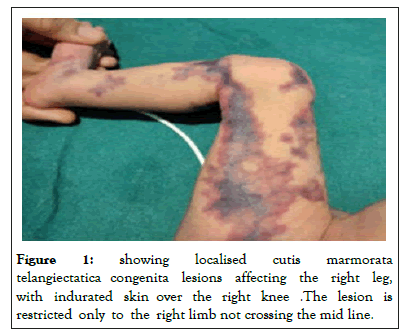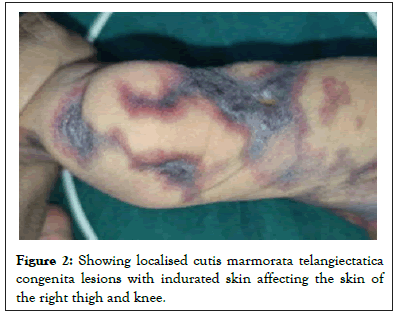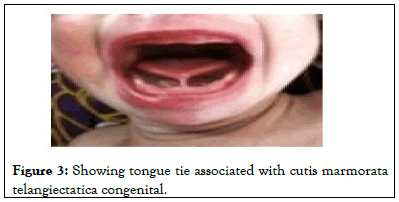Clinical Pediatrics: Open Access
Open Access
ISSN: 2572-0775
ISSN: 2572-0775
Case Report - (2023)Volume 8, Issue 3
Cutis Marmorata Telangiectatica Congenita (CMTC) is an uncommon congenital vascular defect that causes dilation of the capillaries and veins on the skin's surface. Typically presenting at birth, its clinical characteristics include reticulated, erythematous or violaceous skin with a marbled or fishnet appearance. A full-term female neonate, the first born of a non-consanguineous couple presented with dark-red to violaceous atrophic patches resembling a fishnet pattern on the right lower limb. The skin lesions did not cross the midline. Additionally, the patient also presented with tongue-tie and Pink Tetralogy of Fallot which are uncommon CMTC-related abnormalities. A frequent follow up was scheduled for the patient. Surgical correction of the tongue tie was planned. We present this case report because of its rarity and the association between CMTC, Pink Tetralogy of Fallot and tongue tie has not been reported previously.
Cutis marmorata telangiectatica congenital; Pink tetralogy of fallot; Tongue tie; Vascular abnormality
Cutis Marmorata Telangiectatica Congenita (CMTC) is a rare congenital vascular abnormality. The International Society for the Study of Vascular Anomalies classifies it as a simple vascular and a capillary malformation [1]. CMTC presents with welldefined blue to violaceous areas of the skin, exhibiting an interlocking pattern that resembles marbled skin [2]. Application of heat does not cause the lesions to resolve and the lesions may be localized or diffuse. Localized lesions are typically unilateral and well-defined. Defective bone development and other congenital abnormalities have been reported in rare cases [3]. We present a case of CMTC of the right lower limb in a full-term female neonate with Pink Tetralogy of Fallot and tongue tie which has not been reported previously.
A full-term female neonate who presented with dark-red to violaceous atrophic patches resembling a fishnet pattern, was the first born of a non-consanguineous couple. No medications were prescribed during the pregnancy and antenatal period. Since the foetus was in distress, a caesarean section was performed. The neonate’s Apgar scores during the first, fifth and tenth minutes of life were 3/10, 6/10 and 8/10 respectively. The neonate had a birth weight of 2700 g, length of 49.5 cm, and head circumference of 33 cm. The patient had no family history of vascular malformations.
On inspection the patient presented with well-defined, violaceous, reticulated skin lesions on the right lower limb (Figure 1). The skin surrounding the lesions exhibited slight atrophic changes (Figure 2). The skin lesions did not cross the midline. There was no noted mucosal or subcutaneous bleeding in other body regions. Ankyloglossia was also observed (Figure 3).

Figure 1: Showing localised cutis marmorata telangiectatica congenita lesions affecting the right leg, with indurated skin over the right knee. The lesion is restricted only to the right limb not crossing the mid line.

Figure 2: Showing localised cutis marmorata telangiectatica congenita lesions with indurated skin affecting the skin of the right thigh and knee.

Figure 3: Showing tongue tie associated with cutis marmorata telangiectatica congenital.
The haemoglobin level (13.8 g percent), total leukocyte count (6000/mm3) and platelet count (860000/mm3) were obtained within 48 hours of birth. The C-reactive protein level (38.9 mg/L) was within the normal range. The peripheral blood smear revealed anaemia with thrombocytopenia. The patient had normocytic and normochromic erythrocytes.
Great saphenous vein abnormalities were detected by doppler scan of the right lower limb. The muscles appeared hypo echoic, with distended hypo echoic fibres in the fascia of the muscle tissue. The results of the ocular fundus exam were normal and the neuro sonogram results were unremarkable. The patient was diagnosed with Pink Tetralogy of Fallot via echocardiogram.
Based on the patient’s clinical and laboratory findings, particularly the pattern of her cutaneous lesions, she was diagnosed with Cutis Marmorata Telangiectatica Congenita. A frequent follow up was scheduled for the patient. Surgical correction of the tongue tie was planned.
CMTC was first identified as a distinct vascular defect by the Dutch paediatrician Van Lohuizen [4]. CMTC is characterized by reticulated, blue to violaceous, congenital skin vasculitis, accompanied by telangiectasia [5]. In few cases, ulceration is observed in the inflamed or atrophied skin regions [6]. Notably, the actual cause of CMTC has not been identified. Happle suggested two genetic theories, particularly the paradominant inheritance theory and the autosomal lethal mutation that survived through mosaicism [7]. Previous studies have detected GNA11 mutations in skin samples from CMTC affected skin regions [8]. According to one proposed theory, the improper contraction of the skin capillaries was likely caused by the aberrant pericyte recruitment.
CMTC equally affects men and women and it typically presents at birth (congenital). There have been 485 reported cases of CMTC till date. However, this condition is likely underdiagnosed because most cases were self-limited. Thus, the actual prevalence of CMTC in the general population has not been ascertained as yet [9].
Skin histopathology is seldom used as a diagnostic tool for CMTC, which is primarily diagnosed clinically. According to Kienast et al., the diagnosis of CMTC is based on the presence of three major and two minor diagnostic criteria [10]. The major criteria include congenital reticulate erythema, absence of venectasia, and unresponsiveness to local heat therapy. The five minor criteria include resolution of the erythema within two years, telangiectasia, port-wine stain, ulceration, and atrophy. The patient in the present case fulfilled all three major criteria and four minor criteria.
In general, the erythema is broad or restricted to a single limb or body region. Localized lesions are well-defined and do not cross the midline. In terms of colour, the lesions range from deep violet to bright red. In most cases, the skin lesion appears within the first three months of life. However, it can develop up to two years of age. The vascular pattern of the lesions is precipitated by cold weather and crying. However, the application of heat has little to no effect on mottling [11].
Limb asymmetry is the most common anomaly associated with CMTC. Atrophy of the overlying skin is common, and the affected limb may be atrophied or hypertrophied. Additionally, CMTC has been associated with syndactyly, tendinitis stenosans, hip dysplasia, clubfoot, and cleft palate. Thus, a thorough musculoskeletal examination is required to evaluate for these gross deformities. On inspection, the patient in the present case had symmetrical limbs with no abnormalities.
Glaucoma was reportedly the most prevalent ocular complication associated with CMTC [11]. Port wine stains, angiokeratomas, haemangiomas, and Sturge Weber syndrome have also been correlated with CMTC [12,13].
Premature new borns are more likely to have Cutis marmorata, which normally resolves within two months after birth. During the first three years of life, children with CMTC should undergo yearly check-ups to rule out other related abnormalities. No specific treatment has been indicated for the skin lesions secondary to CMTC [14]. Laser therapy is reportedly ineffective. Occlusive dressing is indicated in patients with ulcerated lesions [15]. Most cutaneous symptoms of CMTC resolve during puberty.
The atrophic regions may persist, and in patients with muscular involvement, the hypoplasia of the soft tissues may persist. However, this has not been associated with functional impairment. Cutis Marmorata Telangiectatica Congenita (CMTC) presents during the neonatal period and has an excellent prognosis. Patients with CMTC should be evaluated for ocular and extra cutaneous lesions. The association between CMTC, Pink Tetralogy of Fallot and tongue tie has not been reported previously.
[PubMed]
[Crossref][Google scholar][PubMed].
[Crossref][Google scholar][PubMed].
[Crossref][Google scholar][PubMed].
[Crossref][Google scholar][PubMed].
[Crossref][Google scholar][PubMed].
[Crossref][Google scholar][PubMed].
Citation: Sugapradha GR, Shanbhag M (2023) Cutis Marmorata Telangiectatica Congenita with Pink Tetralogy of Fallot. Clin Pediatr. 8:236.
Received: 01-May-2023, Manuscript No. CPOA-23-21748; Editor assigned: 03-May-2023, Pre QC No. CPOA-23-21748 (PQ); Reviewed: 17-May-2023, QC No. CPOA-23-21748; Revised: 24-May-2023, Manuscript No. CPOA-23-21748 (R); Published: 02-Jun-2023 , DOI: 10.35248/2572-0775.23.8.236
Copyright: © 2023 Sugapradha GR, et al. This is an open-access article distributed under the terms of the Creative Commons Attribution License, which permits unrestricted use, distribution, and reproduction in any medium, provided the original author and source are credited.